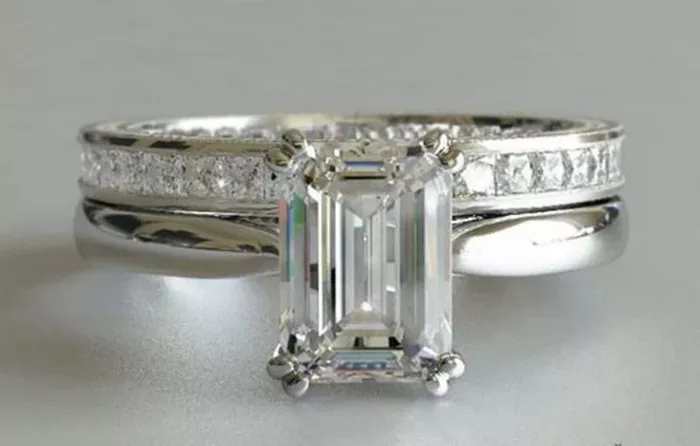Diamonds have long captured the imagination and desire of humanity with their dazzling beauty and enduring allure. However, in a world where synthetic gems and sophisticated imitations abound, ensuring the authenticity of a diamond ring is crucial. Whether you’re purchasing a diamond ring for a special occasion or assessing the authenticity of an heirloom piece, understanding how to discern a real diamond from its imitations is essential. In this comprehensive guide, we’ll explore various methods and expert insights to help you confidently determine whether a diamond ring is authentic.
Explanation of Common Tests
Before delving into professional verification and expert advice, it’s helpful to understand some simple at-home tests that can provide initial indications of a diamond’s authenticity.
1. Water Test: This test exploits the fact that diamonds have high density, causing them to sink rapidly in water. To perform the water test, fill a glass with water and carefully drop the diamond into the glass. If the diamond sinks straight to the bottom, it’s likely real. However, this test isn’t foolproof, as other materials like cubic zirconia can also sink.
2. Fog Test: Another easy test involves breathing on the diamond to create a layer of condensation. Real diamonds disperse heat quickly, so the fog should clear almost instantly. If the fog lingers for several seconds, it may indicate a fake diamond.
3. Dot Test: Place the diamond face down on a piece of paper with printed text. If you can see the text through the diamond, it may be fake. Real diamonds refract light in a way that makes it difficult to see through them.
Professional Verification
While at-home tests can provide initial insights, the most reliable method for authenticating a diamond ring is through professional verification by a certified gemologist. Gemologists are trained to assess diamonds using specialized equipment and expertise. They can perform tests such as thermal conductivity, refractive index, and advanced spectroscopy to determine a diamond’s authenticity definitively. Moreover, a professional appraisal not only confirms the diamond’s authenticity but also provides valuable information about its quality, such as cut, color, clarity, and carat weight.
Characteristics of Real Diamonds
Understanding the unique properties of real diamonds can further aid in authentication:
1. Hardness: Diamonds are the hardest natural substance on Earth, scoring a perfect 10 on the Mohs scale of mineral hardness. This means they can scratch almost any other material, making them resistant to damage.
2. Refractive Index: Diamonds have a high refractive index, which causes light to bend and reflect within the gem, creating the characteristic sparkle known as “fire.”
3. Thermal Conductivity: Diamonds are exceptional thermal conductors, dispersing heat rapidly. This property is exploited in thermal conductivity testers used by gemologists.
Comparison with Common Simulants
To distinguish real diamonds from common simulants like cubic zirconia (CZ) and moissanite, consider the following:
1. Cubic Zirconia (CZ): CZ is a popular diamond simulant known for its affordability and brilliance. However, unlike diamonds, CZ lacks the hardness and thermal conductivity of real diamonds. Additionally, CZ often exhibits less dispersion of light, resulting in less pronounced fire.
2. Moissanite: Moissanite is another diamond simulant that closely resembles diamonds in appearance. While moissanite shares some optical properties with diamonds, it has a different chemical composition and lower hardness.
Jewelry Setting Insights
The quality of the setting can also provide clues about a diamond’s authenticity. Real diamonds are typically set in high-quality metals such as platinum, gold, or high-grade silver. Inspect the setting for craftsmanship and durability, as authentic diamond rings are often accompanied by meticulous detailing and sturdy construction.
Expert Advice
Jewelers and gemologists offer invaluable insights into the authenticity of diamond rings. Some signs they may look for include:
1. Inclusions and Blemishes: Real diamonds often have natural imperfections called inclusions, whereas synthetic diamonds may exhibit fewer or no inclusions. However, the absence of inclusions does not necessarily indicate a fake diamond.
2. Hallmarks and Certifications: Genuine diamond rings are often accompanied by certificates from reputable gemological laboratories such as the Gemological Institute of America (GIA) or the International Gemological Institute (IGI). These certificates provide detailed information about the diamond’s characteristics and serve as proof of authenticity.
Consumer Education
Educating consumers about the value and characteristics of real diamonds versus synthetic ones is paramount. While synthetic diamonds offer affordability and ethical considerations, nothing quite compares to the timeless elegance and rarity of natural diamonds. Understanding the investment potential and emotional significance of real diamonds can empower consumers to make informed purchasing decisions.
FAQs
Here are answers to some frequently asked questions about diamond authenticity:
Can a real diamond scratch glass?
Yes, due to its exceptional hardness, a real diamond can scratch glass.
Are lab-grown diamonds real diamonds?
Lab-grown diamonds have the same chemical composition and physical properties as natural diamonds, making them real diamonds.
How can I tell if a diamond is real without damaging it?
In addition to at-home tests, seek professional verification from a certified gemologist for non-destructive authentication.
Are all diamonds accompanied by certificates?
While certificates enhance transparency and authenticity, not all diamonds come with certificates. However, reputable jewelers often provide certificates for significant purchases.
In conclusion, authenticating a diamond ring requires a combination of at-home tests, professional verification, and expert insights. By understanding the unique properties of real diamonds, distinguishing them from common simulants, and seeking guidance from trusted professionals, consumers can confidently navigate the world of diamond authenticity. Remember, a diamond’s beauty lies not only in its brilliance but also in its authenticity and enduring legacy.


